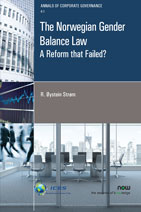The Norwegian Gender Balance Law: A Reform that Failed?
By R. Øystein Strøm, School of Business, OsloMet – Oslo Metropolitan University, Norway, oystst@oslomet.no
Abstract
The Norwegian Gender Balance Law (GBL) was proposed in June 14th 2003, made into a law on December 9th 2005, and implemented from January 1st 2006 with a two-year grace period. The law mandates at least 40% board representation for both gender in PLC companies. The government gave two main promises, one that gender equality would increase with the law, the other that companies’ financial performance would improve. I review research literature and add descriptive long-term developments on these dimensions. This essay concludes that the promises were not fulfilled, and that the corporate governance consequences that did follow are mostly negative. Companies attain the 40% female director target, but besides this, the law does not bring more female managers or CEOs, and the gender segregated labour market remains segregated. Today, the law applies to about 500 women, half of the number at its maximum. An unintended consequence of the legislation is the mass exodus of companies from the PLC register. I find it difficult to compare results from research on financial performance. Researchers perform before-and-after study, a natural experiment, but the reform has a long gestation period and attrition of companies from the PLC register. I conclude that the law should be repealed. In a wider context the experiment casts doubt as to the usefulness of legislation to promote gender equality in the boardroom and in society at large.
The Norwegian Gender Balance Law: A Reform that Failed?
The Norwegian Gender Balance Law: A Reform that Failed? reviews the two promises of Gender Balance Law – the promise of greater gender equality in leadership positions in private companies and the promise of improved firm performance. This review is based on the academic literature together with long-term descriptive statistics before and after the regulation. In order to fully evaluate the reform, the author includes the unintended consequences that follow from the reform and that the lawmakers did not foresee, the most important is what we call the withering of the PLC company. It concludes that the GBL is a failed reform.
